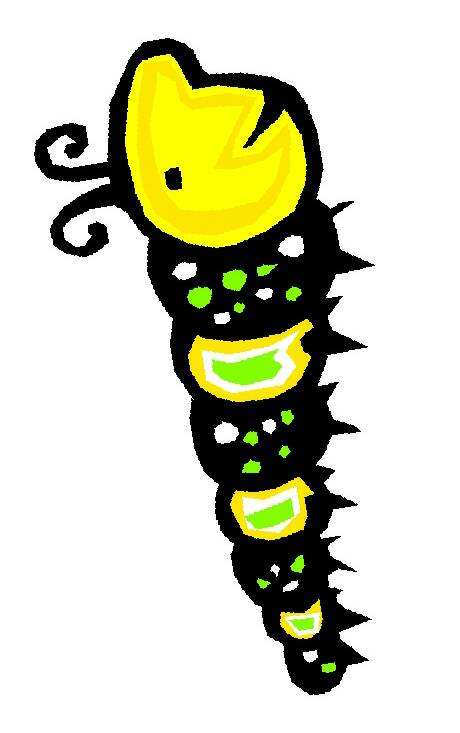C
PLANT MILKWEED!
Each spring, Monarch Butterflies from only a handful of overwintering sanctuaries in Mexico travel to North America in search of milkweed (Asclepias). It's the ONLY plant on which a female Monarch will lay her eggs. When the eggs hatch milkweed is the ONLY plant the Monarch Caterpillars will eat.
Traveling as far north as milkweed shoots appear, Monarchs repopulate the entire United States and parts of Canada each summer. When Autumn arrives, future generations of butterflies make the annual trek back to Mexico in order to escape the inclement weather of winter.
MONARCH BUTTERFLIES NEED YOUR HELP!
DID YOU KNOW? The Monarch Butterfly has the longest migration route of all insects in the United States!
Lawns are the second largest crop grown in the United States! They may look nice, but from an ecological standpoint a lawn is a monoculture, with all the diversity of a wasteland. Chemicals that are poured on these lawns to keep them looking good---these pesticides and herbicides don't spare beneficial insects---eventually end up in our waterways. A more ecologically sound plan is to minimize lawn area, planting instead native grasses, shrubs and trees. Use organic controls for the lawn area remaining.
As a pioneer plant, milkweed is often found growing along roadsides. Unfortunately, many of these plants will be mowed down several times during the Summer with regular township maintenance. When this happens the Monarch eggs and caterpillars which are utilizing the plants are killed. Recently in New Jersey several townships have implemented a practice whereby only a portion of the "weeds" growing alongside roads are cut throughout the Summer season; the rest are cut only once a year during a period when less harm will come to wildlife. This benefits not only milkweed dependant Monarchs but ground nesting birds and native plant species which are allowed to go to seed and reproduce. As well, townships use fewer of your tax dollars on roadside maintenance.
- There are over 2000 species of milkweed world wide
- The United States is host to approximately 110 varieties
- Alaska is the only state that does not have native milkweed
Have you planted YOUR milkweed, yet? }i{
Click to enlarge photo
Click to enlarge photo
THE MILKWEED PATCH IS A TOUGH NEIGHBORHOOD!
WAYSTATIONS
Each day critical Monarch habitats are being destroyed. Planting milkweed amongst flowering plants creates important Monarch Waystations which help future generations of Monarch Butterflies survive. A waystation is simply a garden or meadow which provides both nectar bearing flowers for adult Monarchs and milkweed plants on which the females can lay eggs. It can be as small as a patio garden or as large as many acres. Each becomes a "stepping stone" for the Monarchs as they complete their migration. Consider adding a variety of milkweed species to your garden. The butterflies thank you!
These Assassin Bugs come equipped with their own straws They simply suck the juice out of their victims.
Tachinid Flies lay their eggs in the flesh of caterpillars. When the young hatch they must eat their way out.
Disease can be passed on from parents or picked up from a contaminated surface.
Ladybugs are pretty cute but are amongst the flesh eaters of the milkweed patch. They do help with aphid control.
Spiders will capture and eat both small and large caterpillars.
I want milkweed!
Plant more milkweed!
Some Of The Over 2000 Varieties of Milkweed
Asclepias albicans Whitestem milkweed
Asclepias amplexicaulis Blunt-leaved milkweed
Asclepias asperula Antelope horns
Asclepias californica California milkweed
Asclepias cordifolia
Heart-leaf milkweed
Asclepias cryptoceras Pallid milkweed
Asclepias curassavica Scarlet milkweed, Tropical milkweed
Asclepias eriocarpa Woollypod milkweed
Asclepias erosa
Desert milkweed
Asclepias exaltata
Poke milkweed
Asclepias fascicularis Narrow leaf milkweed
Asclepias humistrata Sandhill milkweed
Asclepias incarnata Swamp milkweed
Asclepias lanceolata Lanceolate milkweed
Asclepias linaria
Pine needle milkweed
Asclepias linearis
Slim milkweed
Asclepias meadii
Mead's milkweed
Asclepias nyctaginifolia Mojave milkweed
Asclepias obovata Pineland milkweed
Asclepias purpurascens Purple milkweed
Asclepias quadrifolia
Four-leaved milkweed
Asclepias rubra
Red milkweed
Asclepias solanoana Serpentine milkweed
Asclepias speciosa
Showy milkweed
Asclepias subulata
Rush milkweed (Leafless milkweed)
Asclepias sullivantii Sullivant's milkweed
Asclepias syriaca
Common milkweed
Asclepias tuberosa Butterfly weed
Asclepias variegata
White milkweed
Asclepias verticillata Whorled milkweed
Asclepias vestita
Woolly milkweed
Asclepias vincetoxicum
Asclepias viridiflora
Do you need milkweeds seeds?
We have a limited supply of milkweed seeds available if you need them.
Send a self addressed envelope and a minimum donation of $3.00 to cover our costs and we will make sure you get an ample supply and planting instructions. We'll pay for shipping!
The butterflies thank you!
MONARCHS & MILKWEED
HUMMINGBIRDS
JUST FOR FUN
SPONSORSHIP PROGRAMS
POLLINATION STATION
POLLINATION
IN THE MEADOW
Pollination Station is is a registered non-profit organization in the
State of New Jersey.
We do not receive funding from any Local, State or Federal governments and rely on your donations to support conservation efforts and bring environmental education programs into our community.











